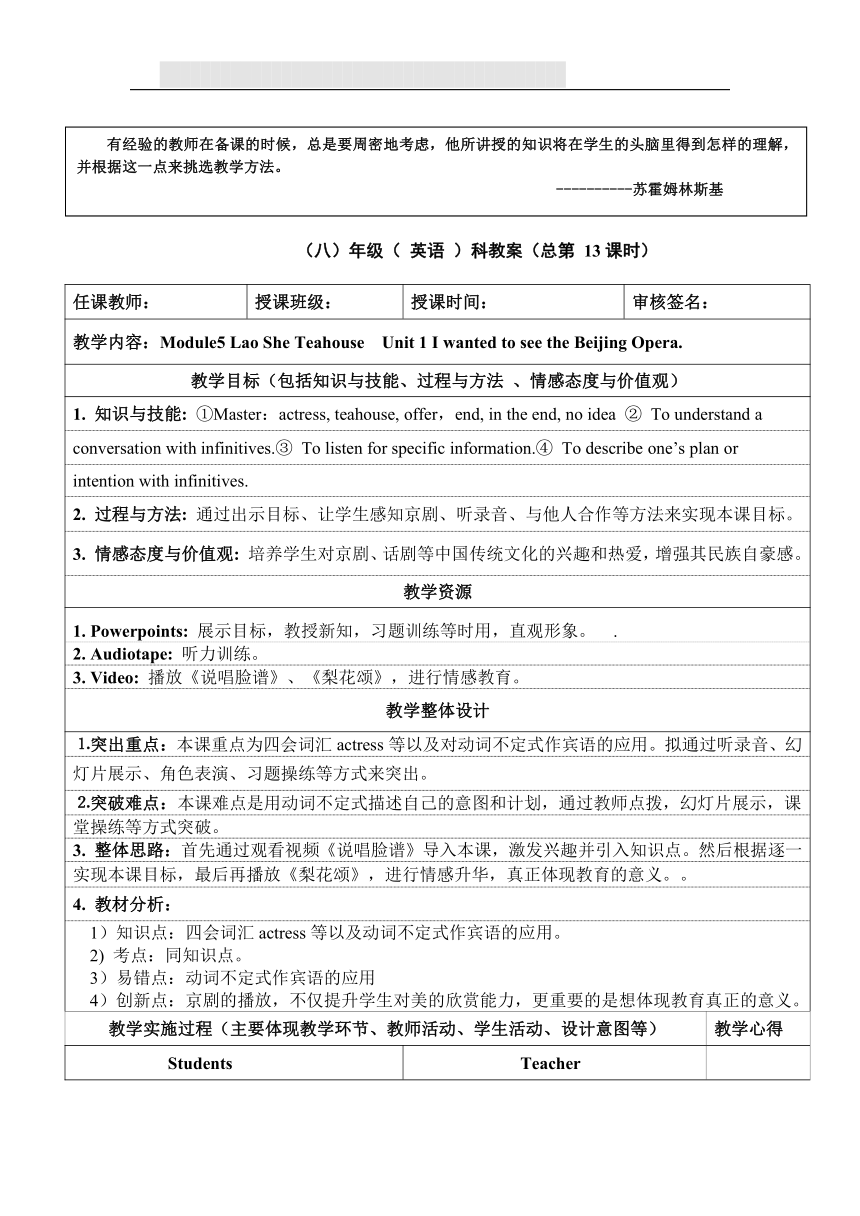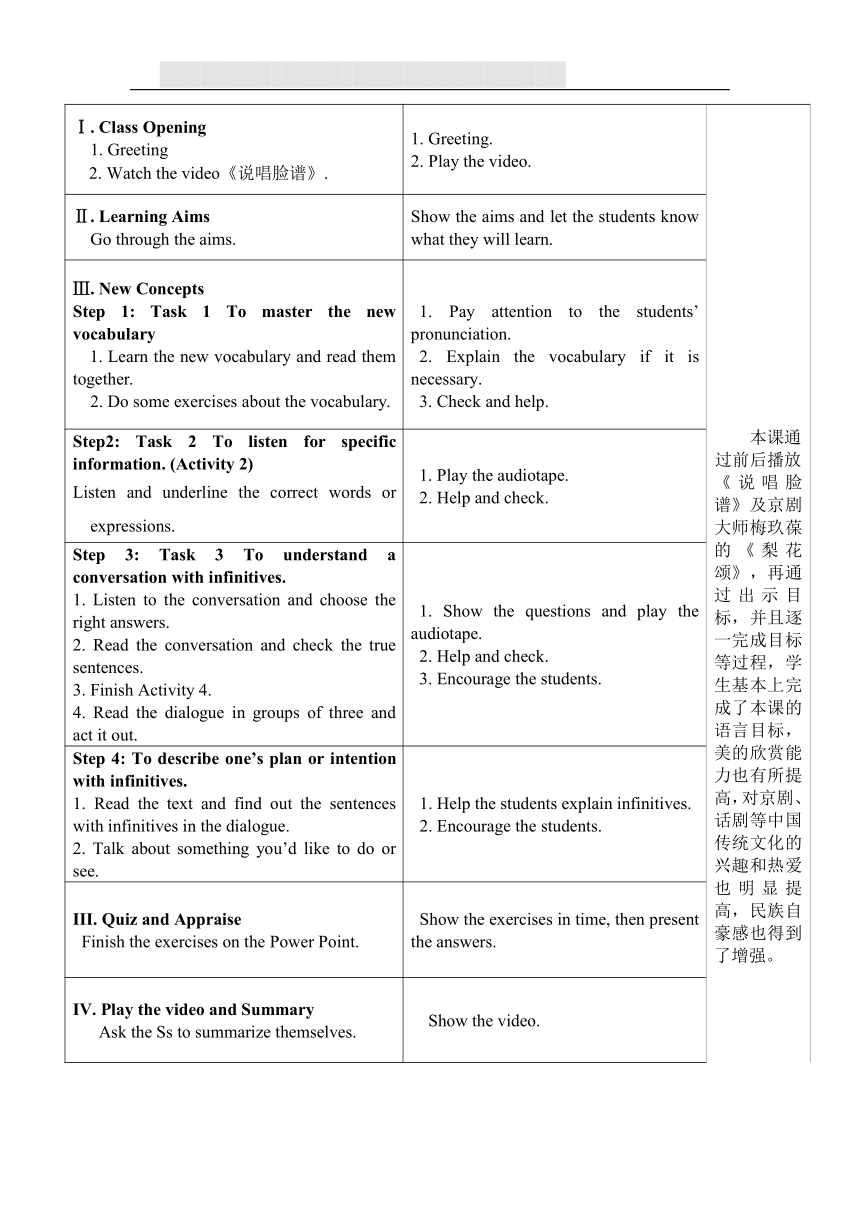外研版八年级上册Module 5 unit1 I wanted to see the Beijing Opera 听说课教案(表格式)
文档属性
| 名称 | 外研版八年级上册Module 5 unit1 I wanted to see the Beijing Opera 听说课教案(表格式) |  | |
| 格式 | doc | ||
| 文件大小 | 46.5KB | ||
| 资源类型 | 教案 | ||
| 版本资源 | 外研版 | ||
| 科目 | 英语 | ||
| 更新时间 | 2023-07-10 19:04:27 | ||
图片预览


文档简介
HYPERLINK "http://image./i ct=503316480&z=0&tn=baiduimagedetail&word=%BB%A8%BB%DC%CD%BC%B0%B8%CB%D8%B2%C4&in=7833&cl=2&cm=1&sc=0&lm=-1&pn=113&rn=1&di=1074948561&ln=383&fr=" \t "_blank" INCLUDEPICTURE "http://t1./it/u=3939948214,804443391&fm=3&gp=11.jpg" \* MERGEFORMAT \d (八)年级( 英语 )科教案(总第 13课时)
任课教师: 授课班级: 授课时间: 审核签名:
教学内容:Module5 Lao She Teahouse Unit 1 I wanted to see the Beijing Opera.
教学目标(包括知识与技能、过程与方法 、情感态度与价值观)
1. 知识与技能: ①Master:actress, teahouse, offer,end, in the end, no idea ② To understand a
conversation with infinitives.③ To listen for specific information.④ To describe one’s plan or
intention with infinitives.
2. 过程与方法: 通过出示目标、让学生感知京剧、听录音、与他人合作等方法来实现本课目标。
3. 情感态度与价值观: 培养学生对京剧、话剧等中国传统文化的兴趣和热爱,增强其民族自豪感。
教学资源
1. Powerpoints: 展示目标,教授新知,习题训练等时用,直观形象。 .
2. Audiotape: 听力训练。
3. Video: 播放《说唱脸谱》、《梨花颂》,进行情感教育。
教学整体设计
⒈突出重点:本课重点为四会词汇actress等以及对动词不定式作宾语的应用。拟通过听录音、幻
灯片展示、角色表演、习题操练等方式来突出。
⒉突破难点:本课难点是用动词不定式描述自己的意图和计划,通过教师点拨,幻灯片展示,课
堂操练等方式突破。
3. 整体思路:首先通过观看视频《说唱脸谱》导入本课,激发兴趣并引入知识点。然后根据逐一
实现本课目标,最后再播放《梨花颂》,进行情感升华,真正体现教育的意义。。
4. 教材分析:
1)知识点:四会词汇actress等以及动词不定式作宾语的应用。2) 考点:同知识点。3)易错点:动词不定式作宾语的应用4)创新点:京剧的播放,不仅提升学生对美的欣赏能力,更重要的是想体现教育真正的意义。
教学实施过程(主要体现教学环节、教师活动、学生活动、设计意图等) 教学心得
Students Teacher
Ⅰ. Class Opening 1. Greeting2. Watch the video《说唱脸谱》. 1. Greeting.2. Play the video. 本课通过前后播放《说唱脸谱》及京剧大师梅玖葆的《梨花颂》,再通过出示目标,并且逐一完成目标等过程,学生基本上完成了本课的语言目标,美的欣赏能力也有所提高,对京剧、话剧等中国传统文化的兴趣和热爱也明显提高,民族自豪感也得到了增强。
Ⅱ. Learning Aims Go through the aims. Show the aims and let the students know what they will learn.
Ⅲ. New ConceptsStep 1: Task 1 To master the new vocabulary 1. Learn the new vocabulary and read them together. 2. Do some exercises about the vocabulary. 1. Pay attention to the students’ pronunciation.2. Explain the vocabulary if it is necessary.3. Check and help.
Step2: Task 2 To listen for specific information. (Activity 2)Listen and underline the correct words or expressions. 1. Play the audiotape.2. Help and check.
Step 3: Task 3 To understand a conversation with infinitives.1. Listen to the conversation and choose the right answers.2. Read the conversation and check the true sentences. 3. Finish Activity 4. 4. Read the dialogue in groups of three and act it out. 1. Show the questions and play the audiotape.2. Help and check.3. Encourage the students.
Step 4: To describe one’s plan or intention with infinitives. 1. Read the text and find out the sentences with infinitives in the dialogue.2. Talk about something you’d like to do or see. 1. Help the students explain infinitives. 2. Encourage the students.
III. Quiz and Appraise Finish the exercises on the Power Point. Show the exercises in time, then present the answers.
IV. Play the video and Summary Ask the Ss to summarize themselves. Show the video.
V. Homework1. Write more sentences to describe your plan with infinitives.2. Preview Unit 2. Show the homework.
作业设计:I. 句型转换 1. He offered me his new bike. ( 改为同义句) He ______ his new bike ______ me.2. Mary tried to get up early. ( 改为否定句) Mary tried ______ ______ get up early. 3. I hope that I will become rich and famous some day. ( 改为同义句) I hope ______ ______ rich and famous some day. 4. I don’t know his name. ( 改为同义句) I have ______ ______ of his name.5. At last, Tom passed the exam. ( 改为同义句)______ ______ ______, Tom passed the exam.II. 用所给词的适当形式填空。 1. He wants ________ (be) an artist.2. My brother offered _______ (take) me to the cinema.3. She decided _______ (stay) at home until the rain stopped.
板书设计: Unit 1: I wanted to see the Beijing Opera.
New vocabulary: actress, teahouse, end, in the end, by the end of…at the end of…no idea,offer to dohope to dohope + that从句 Key sentences: I wanted to see the Beijing Opera, so Lingling offered to take me there. We only planned to watch for an hour, but in the end, we stayed for three hours. I hope to understand more next time.
教后总结:本课是一节听说课,所以在设计时将重点放在了听说上,听力训练、角色朗读、造句
应用等等,孩子们表现还不错。但这些不是我想说的重点,我想说的是我在导课和最后总结时分
别播放了《说唱脸谱》和京剧《梨花颂》,尤其是京剧《梨花颂》,特别的美,绝对的国粹,这
让孩子们在学习语言知识和语言技能的同时,感受到了我们中国传统文化的巨大魅力,无形中增
强了孩子们的民族自豪感。我觉得这才是本课的精髓,这才是教育的意义所在。
有经验的教师在备课的时候,总是要周密地考虑,他所讲授的知识将在学生的头脑里得到怎样的理解,并根据这一点来挑选教学方法。
----------苏霍姆林斯基
任课教师: 授课班级: 授课时间: 审核签名:
教学内容:Module5 Lao She Teahouse Unit 1 I wanted to see the Beijing Opera.
教学目标(包括知识与技能、过程与方法 、情感态度与价值观)
1. 知识与技能: ①Master:actress, teahouse, offer,end, in the end, no idea ② To understand a
conversation with infinitives.③ To listen for specific information.④ To describe one’s plan or
intention with infinitives.
2. 过程与方法: 通过出示目标、让学生感知京剧、听录音、与他人合作等方法来实现本课目标。
3. 情感态度与价值观: 培养学生对京剧、话剧等中国传统文化的兴趣和热爱,增强其民族自豪感。
教学资源
1. Powerpoints: 展示目标,教授新知,习题训练等时用,直观形象。 .
2. Audiotape: 听力训练。
3. Video: 播放《说唱脸谱》、《梨花颂》,进行情感教育。
教学整体设计
⒈突出重点:本课重点为四会词汇actress等以及对动词不定式作宾语的应用。拟通过听录音、幻
灯片展示、角色表演、习题操练等方式来突出。
⒉突破难点:本课难点是用动词不定式描述自己的意图和计划,通过教师点拨,幻灯片展示,课
堂操练等方式突破。
3. 整体思路:首先通过观看视频《说唱脸谱》导入本课,激发兴趣并引入知识点。然后根据逐一
实现本课目标,最后再播放《梨花颂》,进行情感升华,真正体现教育的意义。。
4. 教材分析:
1)知识点:四会词汇actress等以及动词不定式作宾语的应用。2) 考点:同知识点。3)易错点:动词不定式作宾语的应用4)创新点:京剧的播放,不仅提升学生对美的欣赏能力,更重要的是想体现教育真正的意义。
教学实施过程(主要体现教学环节、教师活动、学生活动、设计意图等) 教学心得
Students Teacher
Ⅰ. Class Opening 1. Greeting2. Watch the video《说唱脸谱》. 1. Greeting.2. Play the video. 本课通过前后播放《说唱脸谱》及京剧大师梅玖葆的《梨花颂》,再通过出示目标,并且逐一完成目标等过程,学生基本上完成了本课的语言目标,美的欣赏能力也有所提高,对京剧、话剧等中国传统文化的兴趣和热爱也明显提高,民族自豪感也得到了增强。
Ⅱ. Learning Aims Go through the aims. Show the aims and let the students know what they will learn.
Ⅲ. New ConceptsStep 1: Task 1 To master the new vocabulary 1. Learn the new vocabulary and read them together. 2. Do some exercises about the vocabulary. 1. Pay attention to the students’ pronunciation.2. Explain the vocabulary if it is necessary.3. Check and help.
Step2: Task 2 To listen for specific information. (Activity 2)Listen and underline the correct words or expressions. 1. Play the audiotape.2. Help and check.
Step 3: Task 3 To understand a conversation with infinitives.1. Listen to the conversation and choose the right answers.2. Read the conversation and check the true sentences. 3. Finish Activity 4. 4. Read the dialogue in groups of three and act it out. 1. Show the questions and play the audiotape.2. Help and check.3. Encourage the students.
Step 4: To describe one’s plan or intention with infinitives. 1. Read the text and find out the sentences with infinitives in the dialogue.2. Talk about something you’d like to do or see. 1. Help the students explain infinitives. 2. Encourage the students.
III. Quiz and Appraise Finish the exercises on the Power Point. Show the exercises in time, then present the answers.
IV. Play the video and Summary Ask the Ss to summarize themselves. Show the video.
V. Homework1. Write more sentences to describe your plan with infinitives.2. Preview Unit 2. Show the homework.
作业设计:I. 句型转换 1. He offered me his new bike. ( 改为同义句) He ______ his new bike ______ me.2. Mary tried to get up early. ( 改为否定句) Mary tried ______ ______ get up early. 3. I hope that I will become rich and famous some day. ( 改为同义句) I hope ______ ______ rich and famous some day. 4. I don’t know his name. ( 改为同义句) I have ______ ______ of his name.5. At last, Tom passed the exam. ( 改为同义句)______ ______ ______, Tom passed the exam.II. 用所给词的适当形式填空。 1. He wants ________ (be) an artist.2. My brother offered _______ (take) me to the cinema.3. She decided _______ (stay) at home until the rain stopped.
板书设计: Unit 1: I wanted to see the Beijing Opera.
New vocabulary: actress, teahouse, end, in the end, by the end of…at the end of…no idea,offer to dohope to dohope + that从句 Key sentences: I wanted to see the Beijing Opera, so Lingling offered to take me there. We only planned to watch for an hour, but in the end, we stayed for three hours. I hope to understand more next time.
教后总结:本课是一节听说课,所以在设计时将重点放在了听说上,听力训练、角色朗读、造句
应用等等,孩子们表现还不错。但这些不是我想说的重点,我想说的是我在导课和最后总结时分
别播放了《说唱脸谱》和京剧《梨花颂》,尤其是京剧《梨花颂》,特别的美,绝对的国粹,这
让孩子们在学习语言知识和语言技能的同时,感受到了我们中国传统文化的巨大魅力,无形中增
强了孩子们的民族自豪感。我觉得这才是本课的精髓,这才是教育的意义所在。
有经验的教师在备课的时候,总是要周密地考虑,他所讲授的知识将在学生的头脑里得到怎样的理解,并根据这一点来挑选教学方法。
----------苏霍姆林斯基
同课章节目录
- Module 1 How to learn English
- Unit 1 Let's try to speak English as much as possi
- Unit 2 You should smile at her.
- Unit 3 Language in use .
- Module 2 My home town and my country
- Unit 1 It's taller than many other buildings.
- Unit 2 Cambridge is a beautiful city in the east o
- Unit 3 Language in use .
- Module 3 Sports.
- Unit 1 Nothing is more exciting than playing tenni
- Unit 2 This year we training more carefully.
- Unit 3 Language in use .
- Module 4 Planes, ships and trains .
- Unit 1 He lives the farthest from school.
- Unit 2 What is the best way to travel.
- Unit 3 Language in use .
- Module 5 Lao She Teahouse.
- Unit 1 I wanted to see the Beijing Opera.
- Unit 2 It descibes the changes in Chinese society.
- Unit 3 Language in use .
- Module 6 Animals in danger.
- Unit 1 It allows people to get closer to them .
- Unit 2 The WWF is working hard to save them all.
- Unit 3 Language in use .
- Revision module A
- Module 7 A famous story
- Unit 1 Alice was sitting with her sister by the ri
- Unit 2 She was thinking about her cat.
- Unit 3 Language in use .
- Module 8 Accidents
- Unit 1 While the car were changing to red, a car s
- Unit 2 I was trying to pick it up when it bite me
- Unit 3 Language in use .
- Module 9 Population
- Unit 1 The population of China is about 1.37 billi
- Unit 2 Arnwick was a city with 200,000 people.
- Unit 3 Language in use .
- Module 10 The weathe
- Unit 1 It might snow.
- Unit 2 The weather is fine all year round.
- Unit 3 Language in use .
- Module 11 Way of life
- Unit 1 In China ,we open a gift later.
- Unit 2 In England, you usually drink tea with milk
- Unit 3 Language in use .
- Module 12 Help
- Unit 1 What should we do before help arrives?
- Unit 2 Stay away from windows and heavy furniture.
- Unit 3 Language in use .
- Revision module B
